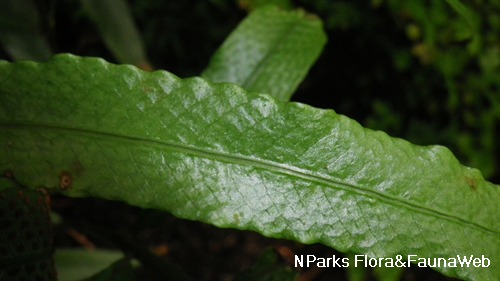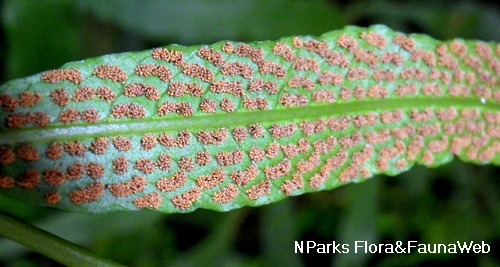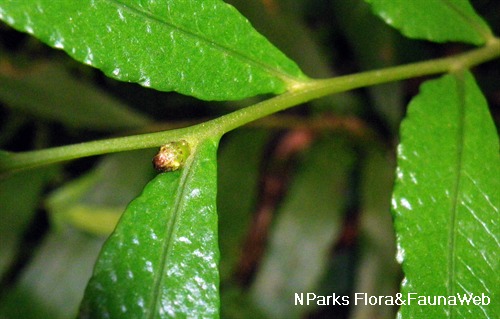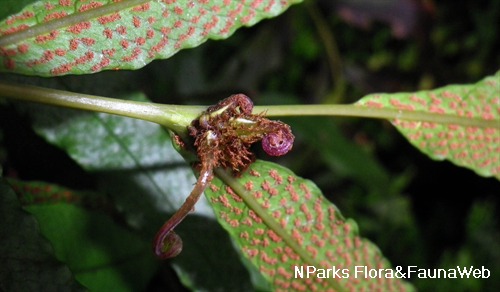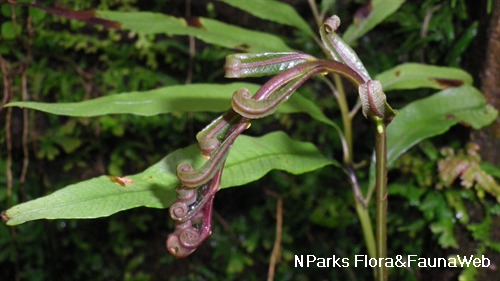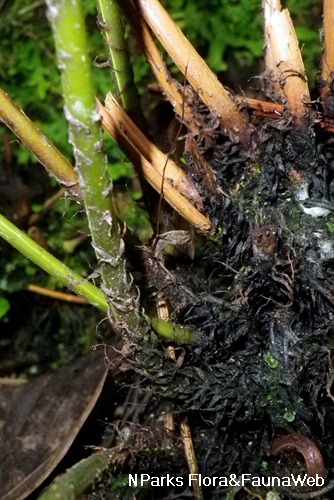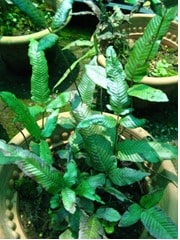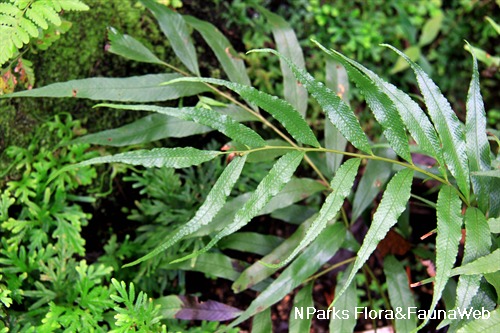
Back
Grypothrix salicifolia (Wall. ex Hook.) S.E.Fawc. & A.R.Sm.
| Family Name: | Thelypteridaceae |
| Synonyms: | Cyclosorus salicifolius (Wall. ex Hook.) Copel., Pronephrium salicifolium (Wall. ex Hook.) Holttum |
Grypothrix salicifolia is a non-native terrestrial fern, adapted to grow in fast-flowing waters. It has pinnate fronds held by a long stipe that is typically glabrous and smooth except the base where hooked hairs and rigid dark scales are found. Sori are elongated, found along the veins.
Name
Classifications and Characteristics
| Plant Division | Ferns & Lycophytes (Non-Seed Vascular Plants) (Fern) |
|---|---|
| Plant Growth Form | Herbaceous Plant |
| Lifespan (in Singapore) | Perennial |
Biogeography
| Native Distribution | Vietnam, Thailand, Peninsula Malaysia, Borneo, Sumatra |
|---|---|
| Native Habitat | Terrestrial (Riverine), Aquatic (Freshwater Pond / Lake / River) |
| Preferred Climate Zone | Tropical |
| Local Conservation Status | Non-native |
Description and Ethnobotany
| Growth Form | It is a terrestrial fern that has adapted to fast-flowing waters (Rheophyte). |
|---|---|
| Foliage | The frond is pinnate, firm, up to 18 pairs of leaflets measuring 30 - 80 cm in length. The blade is held on a long stalk, 20 - 60 cm long. While the stalk remains glabrous and smooth, hooked hairs and rigid dark scales are found at the base. Leaflets grow between 10 - 15 cm long, fertile leaflets tend to be slightly narrow measuring 0.6 - 1.2 cm wide, rarely to 2 cm in width. A bud may be present at the base of the leaflet pair at the tip. |
| Reproductive Parts - non-flowering plant | The sori are elongated along the veins. |
| Others - Plant Morphology | The rhizomes are short-creeping, bearing sparse hooked hairs. |
| Habitat | Occurs on rocks, in and next to streams in forest, flood zone at 0 - 500 m altitude. <1> |
| Cultivation | It can be propagated by spores. |
| Etymology | The specific epithet 'salicifolia' refers to the appearance of the fronds, as they resemble Willow leaves (Salix spp.) |
Landscaping Features
| Desirable Plant Features | Ornamental Foliage, Ornamental Form |
|---|---|
| Landscape Uses | Small Gardens, Riverine, Container Planting, Suitable for Hanging Baskets |
| Thematic Landscaping | Naturalistic Garden, Water Garden |
Plant Care and Propagation
| Light Preference | Semi-Shade, Full Shade |
|---|---|
| Water Preference | Lots of Water, Occasional Misting |
| Rootzone Tolerance | Moist Soils, Waterlogged Soils, Fertile Loamy Soils |
| Propagation Method | Spore, Division, Aerial Plantlet |
Foliar
| Foliage Retention | Evergreen |
|---|---|
| Mature Foliage Colour(s) | Green |
| Mature Foliage Texture(s) | Thin |
| Prominent Young Flush Colour(s) | Green, Purple |
| Young Flush Texture(s) | Thin |
References
| References | <1> Holttum, R.E. (1959). Pronephrium. In: Holttum, R.E. (eds). Thelypteridaceae. Flora Malesiana. ser. 2, Pteridophyta, vol. 5, pt. 1, pp. 535-536, Leiden: Rijksherbarium. <1> |
|---|
Image Repository
Others
| Master ID | 31556 |
|---|---|
| Species ID | 5955 |
| Flora Disclaimer | The information in this website has been compiled from reliable sources, such as reference works on medicinal plants. It is not a substitute for medical advice or treatment and NParks does not purport to provide any medical advice. Readers should always consult his/her physician before using or consuming a plant for medicinal purposes. |

